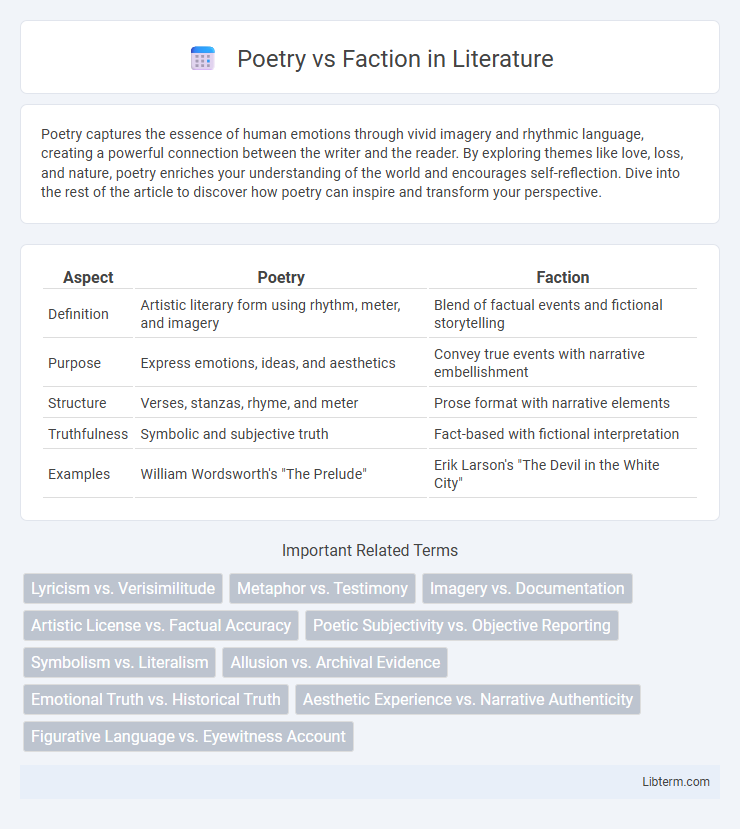Poetry captures the essence of human emotions through vivid imagery and rhythmic language, creating a powerful connection between the writer and the reader. By exploring themes like love, loss, and nature, poetry enriches your understanding of the world and encourages self-reflection. Dive into the rest of the article to discover how poetry can inspire and transform your perspective.
Table of Comparison
| Aspect | Poetry | Faction |
|---|---|---|
| Definition | Artistic literary form using rhythm, meter, and imagery | Blend of factual events and fictional storytelling |
| Purpose | Express emotions, ideas, and aesthetics | Convey true events with narrative embellishment |
| Structure | Verses, stanzas, rhyme, and meter | Prose format with narrative elements |
| Truthfulness | Symbolic and subjective truth | Fact-based with fictional interpretation |
| Examples | William Wordsworth's "The Prelude" | Erik Larson's "The Devil in the White City" |
Understanding Poetry: An Artistic Expression
Poetry is an artistic expression that conveys emotions, ideas, and imagery through structured language, rhythm, and metaphor, emphasizing creativity over factual accuracy. Unlike faction, which blends fact and fiction to inform or persuade, poetry seeks to evoke personal interpretation and emotional resonance. Understanding poetry involves appreciating its symbolic language and thematic depth rather than literal truth.
Defining Faction: Where Fact Meets Fiction
Faction blends historical facts with creative storytelling, creating narratives that are rooted in reality yet enhanced with fictional elements. This genre challenges traditional poetry by intertwining documented events and imaginative interpretation, providing a compelling way to convey truth through artistic expression. Readers experience a balanced fusion where factual accuracy meets narrative invention, enriching their understanding of real-world subjects.
Historical Origins of Poetry and Faction
Poetry originated in ancient oral traditions, often used to preserve history, mythology, and cultural values through rhythmic and mnemonic devices. Faction, a blend of fact and fiction, emerged in the 20th century as a narrative technique that weaves real historical events with imaginative storytelling. Both forms reflect the human desire to interpret and communicate reality, yet poetry emphasizes emotional resonance while faction strives for a balanced representation of truth and creativity.
Core Elements: Comparing Structure and Style
Poetry emphasizes rhythmic structure, meter, and metaphorical language to evoke emotion and provoke thought, while faction blends factual accuracy with narrative techniques common to fiction, aiming for engaging yet informative storytelling. The core elements of poetry often include stanzas, rhyme schemes, and imagery, contrasting with faction's reliance on factual content, character development, and plot to convey real events creatively. Comparing these, poetry's stylistic flourishes prioritize aesthetic and symbolic expression, whereas faction's structure balances authenticity with artistic license to maintain reader interest.
The Role of Imagination in Poetry and Faction
Imagination in poetry transforms abstract ideas into vivid sensory experiences, enabling readers to explore emotions and concepts beyond literal reality. Faction blends factual events with fictional elements, relying on imagination to fill narrative gaps and enhance storytelling while maintaining historical context. Both poetry and faction harness imaginative power to deepen understanding and evoke emotional resonance, though poetry focuses more on symbolic interpretation, whereas faction emphasizes narrative authenticity.
Emotional Impact: Evoking Feelings vs. Conveying Truth
Poetry excels at evoking deep emotional responses through vivid imagery, metaphor, and rhythm, allowing readers to experience feelings such as love, sorrow, and joy on a personal level. Faction prioritizes conveying factual truth and objective reality, aiming to inform and persuade by presenting verifiable events and logical arguments. The emotional impact of poetry stems from its ability to connect with the human psyche intuitively, while faction relies on credibility and evidence to resonate intellectually with its audience.
Truth versus Creativity: Blurring the Lines
Poetry and faction both explore truths but differ in their approach to creativity and factual accuracy. Poetry employs metaphor, symbolism, and imaginative language to reveal emotional or philosophical truths beyond literal facts. Faction blends factual events with creative storytelling, blurring lines between objective truth and narrative interpretation.
Literary Significance in Modern Literature
Poetry and faction both hold unique literary significance in modern literature, with poetry emphasizing emotional depth, rhythm, and symbolic language to evoke subjective experiences. Faction blends factual history with narrative storytelling, offering a hybrid form that challenges traditional genre boundaries while providing readers with immersive, thought-provoking perspectives. The interplay between poetry's expressive intensity and faction's factual grounding enriches contemporary literary discourse, fostering innovative explorations of truth and imagination.
Notable Works: Poetry and Faction Examples
Notable works of poetry include William Blake's "Songs of Innocence and Experience" and Sylvia Plath's "Ariel," both celebrated for their emotional depth and innovative style. In the realm of faction, Truman Capote's "In Cold Blood" and Norman Mailer's "The Executioner's Song" stand out for blending factual reportage with narrative techniques typical of fiction. These exemplary texts highlight the distinct yet overlapping narrative strengths of poetry and faction genres.
Choosing Your Path: Which Form Inspires You?
Poetry ignites the imagination through vibrant imagery and emotional depth, while faction blends factual storytelling with creative narrative to engage critical thinking. Choosing your path depends on whether you seek the expressive freedom of verse or the compelling structure of reality-infused tales. Both forms inspire unique perspectives, shaping how stories resonate and influence personal reflection.
Poetry Infographic

 libterm.com
libterm.com